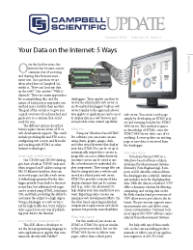Campbell Scientific has always had the philosophy of building our own products and developing our capability to do so. From the beginning there was an attitude that “we can do it.” The board of directors has consistently supported the purchase of equipment to develop good processes. Exceptions have been made for parts that can be produced for less using a particular piece of equipment that we do not own or that is outside of our core competencies. In those cases, we've developed good supplier relationships to get high-quality parts in reasonable time for a good value. Some specific products or processes that we do partner with suppliers on are bare printed circuit boards and anodizing, plating, and powder-coat painting of our fabricated metal parts.
We are characterized as a discrete manufacturer of high-mix/low-volume, highly reliable products. Over time, we have gotten deeply involved in system integration and other value-added services. More of our customers want a complete system that we configure and integrate for them. Outsourcing this type of work is just not practical, nor would it save money. There is also a high dependence on long-term, skilled employees—many of whom have been with the company for over 20 years.
A third of our products are either configured to order, built to order, assembled to order, or even engineered to order—or they are otherwise custom or nonstandard products specified by application engineers. The rest of the products can be made ahead of receiving the customer order: built to stock. We also build some products or subassemblies for affiliated companies.
We carry an inventory of over 15,000 unique part numbers. Planning is done with the aid of an enterprise resource planning (ERP) system by a team of people trying to anticipate the needs of customers. We strive to have parts available and many products or subassemblies made in advance of the customer order. Building high-quality products is always the main goal.
Production is divided into work units concentrating on their areas of responsibility and keeping their processes in control. Employees are also widely cross-trained for better response to product demand. The various work units focus on:
- Receiving, inspection, and inventory
- Surface-mount electronic assembly of printed circuit boards
- Sensor and cable assembly
- Final mechanical assembly
- System assembly
- Metal fabrication
- Electronics testing
- Shipping
Lean-manufacturing principles like pull scheduling, work cells, singlepiece flow, and inventory at the point of use are also implemented. Work orders are issued and a quality system is followed.
Many industrial processes are used: soldering, cleaning, potting, molding, conformal coating, precision metal forming, machining, and welding of stainless steel, aluminum, and cold-rolled steel.
A team of experienced planning, scheduling, and purchasing professionals is responsible for getting the correct component parts delivered in time to build products in anticipation of customer orders. Everyone is involved to coordinate the production plan with actual customer demand. We do everything we can to ship high-quality products to our customers on time.
Manufacturing Vision Statement
We in the Manufacturing Department strive to meet both internal and external customers’ expectations in a professional manner. Our objectives for 2008 are
- Build good quality products, measured through testing of those products and adherence to our quality system.
- Provide on-time shipment to customer orders, measured each week and reported in management meeting.
- Strive to complete work orders on time, measured and reported each week in the production supervisors meeting.

